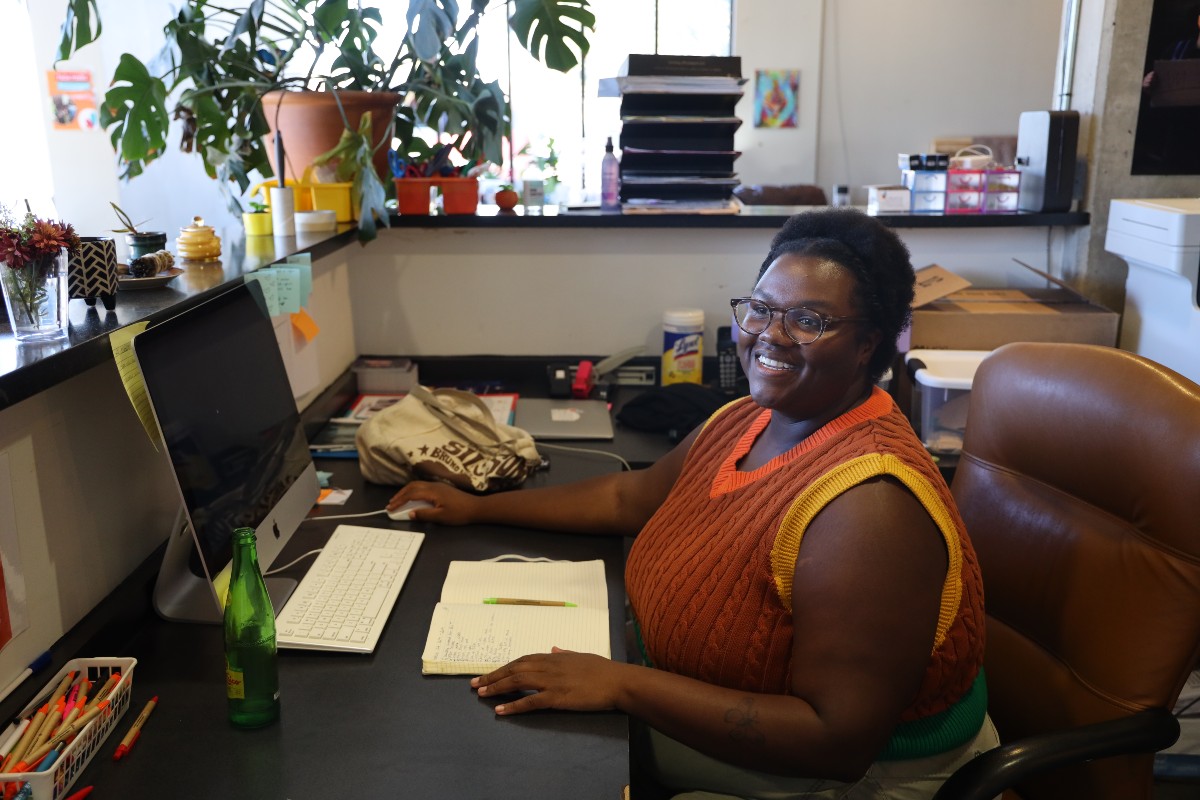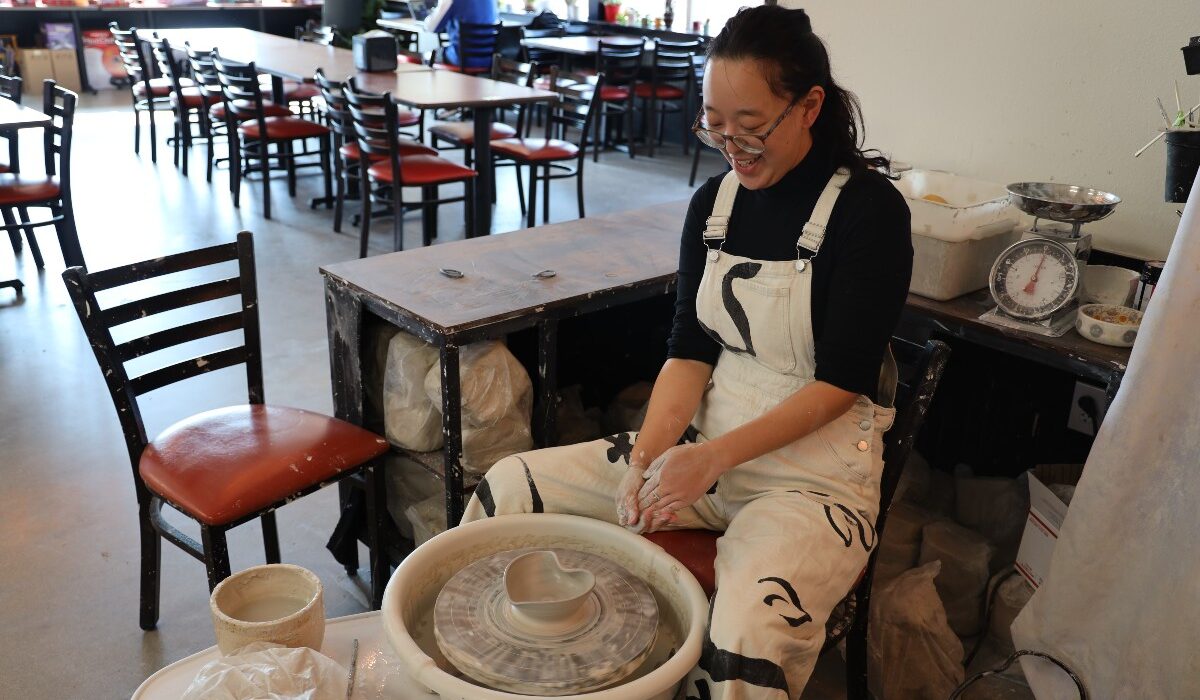It’s lunchtime at Coark Collective, a Korean food hall in Centennial. Vendors whip up dumplings and bibimbap, friends catch up over spicy gom tang soup and Hannah Lim sits at her pottery wheel, gracefully shaping a lump of clay into a heart-shaped bowl.
Lim started her pottery studio, aptly named Art at Coark, in January. She knew the founders of Coark Collective, who approached her with the idea of opening a studio and selling her art in their food hall.
Most people don’t expect to find a pottery studio within a food hall, Lim admitted. But she said the unconventional location helps her create community with a wide range of people, not just those who choose to walk into a pottery studio.
At her studio, Lim creates and sells her own ceramic pieces and offers a variety of pottery classes.
Lim described her friendship with a woman who she gives pottery lessons to. The woman always wanted to learn pottery, but she struggled to find someone who could teach her in Korean. After visiting the food hall, she finally found that teacher in Lim.
Now, she comes in several times a week for lessons, and the two of them sometimes go out for lunch.
“Since she started doing pottery, she’s also explored more into the arts at home,” Lim said. “The fact that she’s able to communicate with another person about her artistic endeavors and her creative ideas was something that was really big for her.”
Representation plays a key role in whether someone is going to take an interest in the arts, Lim said. Lim wasn’t exposed to the fine arts growing up, which limited her idea of what she could accomplish in the industry. During the summer of 2020, Lim participated in a diversity-focused internship program that expanded her perspective.
“The main thing that I gained from that internship was a lot of empowerment,” Lim said. “Even being an art major, I had that struggle of what can I do in the arts? After [the internship], I had been like, I can do anything I want in the arts and make it work.”
The Diversity in the Arts internship program, run by the Art Students League of Denver, is geared towards college students or recent graduates from communities who don’t often see themselves reflected in the arts, including students of color, LGBTQ+ students and students with disabilities.
Organizations apply to be “host sites,” and interns are then matched with an organization based on their interests and aspirations.
“Seeing that the primary focus was highlighting people who weren’t previously in art museums was a really big factor for me,” Lim said. “It didn’t hit me that I had felt previously marginalized until I was in a room where everyone was represented.”

As a performer, Keandra Hunt is no stranger to the spotlight. As an activist, they pursued a career to make a difference behind the scenes.
Photo: Carly Rose, Rocky Mountain PBS.
For Keandra Hunt, art takes shape on the stage, not the pottery wheel. Hunt fell in love with the theater community, which they described as a welcoming space that makes “the normal weird and the weird normal.”
But Hunt became frustrated by the lack of representation in popular media. They said it was hard for them to see themself in roles that weren’t telling stories of trauma or liberation.
“As a plus size, nonbinary, queer, femme, Black actor, I just didn’t see a lot of me in media,” Hunt said. “I got the thought process that I can help from behind the scenes. I knew I needed to get a better understanding of administration, so I feel like DITA gave me that groundwork and that basic entry level.”
Hunt applied for the DITA internship program in 2022 after graduating from Texas Tech University with a degree in acting. Originally from Texas, Hunt knew they wanted to live in Colorado eventually.
“I really wanted to do the program because I wanted to build a community here,” Hunt said. “The internship itself centering youth, newer-generation voices and the social justice — the diversity, equity and inclusion specifically — and the location are what drew me to DITA.”
Hunt interned at Creative Strategies for Change, a Denver nonprofit that organizes arts programs and educational services to advocate for social justice.
After the 3-month internship ended, CSC hired Hunt to stay on as the Community and Youth Programs Coordinator.
Hunt organizes several free programs and workshops to give people the tools to express themselves through art.
One program that Hunt is especially excited about is Community Cypher, a monthly open mic night open to all ages and genres. At this free event, hosted at CSC’s office in Five Points, people are encouraged to share their creativity and perspective with their community.
“We have a four-part framework that we interweave in all the things that we do: identity matters, place matters, oppression exists, and community activation,” Hunt said.
Using the administrative and community building skills they developed at CSC, Hunt hopes to become a leader within the casting industry to advocate for more diverse stories on the stage and the screen.
Last year, almost 80% of actors in movies released in theaters were white, according to UCLA’s most recent Hollwood Diversity Report. That same year, just 1% of lead actors in streaming films identified as nonbinary or transgender.
“Historically, the voices and the people that were behind the table were typically white cis individuals,” Hunt said. “When we have people of all the things — size, color, queerness — it allows for conversations to steer more in directions of more marginalized groups.”
People often tell Hunt that they seem like a natural leader, but Hunt never saw themself that way. Now, with a year and a half at CSC under their belt, that’s beginning to change, largely because of the representation Hunt saw within the organization’s leadership.
“The team was all BIPOC femmes, and I was like, these are other people who look like me, sound like me, talk like me,” Hunt said. “Just being in that environment also helped me have more confidence in myself.”
Hannah Lim’s pottery studio neighbors the food vendors at Coark Collective, a Korean food hall. She likes bringing art into a space where people don’t expect it because it creates unexpected connections.
Photo: Carly Rose, Rocky Mountain PBS.
Lim interned at the Arvada Center for the Arts and Humanities, which hosts galleries, theater performances and arts education classes. She worked on the development team, helping out with events and diversity, equity and inclusion initiatives.
Promoting conversations about DEI is a main component of the internship program. Getting more diverse voices in the room is the first step, but the next step is ensuring those voices are heard and valued.
Lim said it’s important for people to see what a healthy workplace should look like, so they feel empowered to advocate for themselves in less-than-welcoming environments.
“People who are just now getting into the workforce or who are just now starting in the arts are saying, okay, this is how it should operate if everyone is welcomed,” Lim said. “Then they are further armed and equipped to deal with other situations.”
Following her internship at the Arvada Center in 2020, Lim worked as a studio assistant for a pottery artist in Denver and as an art educator at the Clyfford Still Museum before launching her own studio at the Coark Collective.
When designing the classes at her studio, Lim made sure she could accommodate students with physical disabilities that might limit their ability to use the wheel or control the clay. Lim became cognizant of accessibility in art while working at the Arvada Center with another DITA intern who was passionate about the subject.
“To be initially exposed to identity issues that I had not experienced was really, really important in shaping how I wanted the business to look like,” Lim said.
Both alumni are members on the DITA internship program’s advisory board. They use their personal experience to suggest improvements and connect with current interns.
The internship program helped Lim and Hunt find a foot in the door of the arts industry. Now, they’re using their positions to hold the door open for others.
“Seeing that exposure is really important to seeing that it can work,” Lim said. “And not only that it can work, but there are other people that you can connect with, and there’s a community of people in that sphere that can help you.”
Carly Rose is the journalism intern at Rocky Mountain PBS. carlyrose@rmpbs.org

